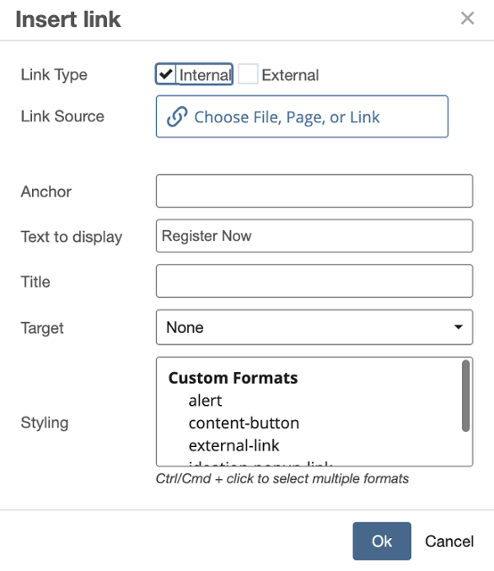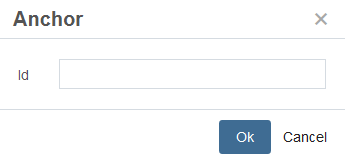Links & Anchors
Understanding Internal vs. External links
An internal link is one going to a page you can browse to and view within Cascade. If you're a www.wm.edu user, this means pages in any www.wm.edu folder. If you're a mason.wm.edu user, this means links to pages within mason.wm.edu, and so on. Any other links are considered external.
Learn about best practices for links and navigation in the Writing & Style Guide.
Creating Links
 Insert/edit link
Insert/edit link
-
Select a link source of Internal or External
- For an internal source, click the Choose File, Page or Link button to browse or search for the link in Cascade. For an external source, provide the full URL (including the "http://").
- If you are linking to an anchor point on a page, include the name of the anchor in the Anchor field.
- If it is necessary to open your link in a new window, select New Window from the Target dropdown.
Note: We recommend always opening internal links in the same window/tab. In addition, the standard practice for www.wm.edu is to open ALL links in the same window/tab, unless the visitor experience is improved by opening the link in a new window/tab. For example, you may decide to open a link in a new window/tab if it's a page where your visitor must follow instructions on your initial page while they access the destination page. - If you are creating a content button with your link, you can use the Styling field to select the content-button format (this can also be applied later using the formats sub-menu).
 Unlink - removes the selected link
Unlink - removes the selected link
Anchors
 Insert/Edit Anchor
Insert/Edit Anchor
Creating anchors is a two-step process. You'll need to first place an anchor within a page (where visitors will land after clicking your link), and then create the link to this anchor point.
Step 1: Create an anchor on a page.
 Edit the page where you want users to land.
Edit the page where you want users to land.- Place your cursor in the content area, exactly where you want them to land.
- Click the Anchor button (
 ).
). - Fill in an ID for the anchor and select OK. For best results, the ID should be brief, unique and all lowercase with no spaces. Dashes are allowed.
Looking to add an anchor to a row? That's done a little differently.
Step 2: Create a link to the anchor in your content.
- A link can be added within the same page as the anchor, or on a different page.
- Create a link, selecting Internal for the link source. If the anchored location is within the same page, don't choose a page link (it will default to the current page). If the anchor is on a different page, use the chooser to select the page.
- In the Anchor field, type in the ID you created in Step 1. You do not need to put the # symbol in front of the ID — for those familiar with this step in other systems, Cascade takes care of this for you.
- Select OK to insert the link.














